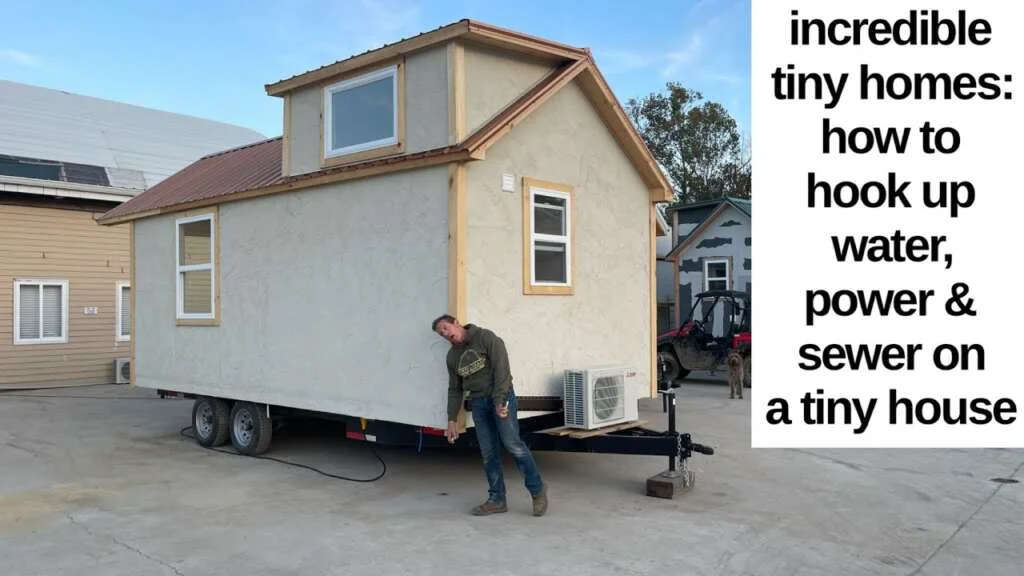So you’ve made the exciting decision to live in a tiny home, but now you’re wondering how to connect it to water and sewage. No worries, we’ve got you covered! In this article, we’ll explore the various options available for connecting your tiny home to water and sewage systems, whether you’re parked on your own property or in a designated community. From traditional hook-ups to innovative off-grid solutions, we’ll help you navigate the process and find the best solution for your tiny home lifestyle. Get ready to embark on your tiny home adventure with confidence!

Connecting to Water
Locating a water source
When it comes to connecting your tiny home to a water source, the first step is to locate a suitable water source. This can be a public water supply, a well, a nearby river or lake, or even rainwater harvesting. Consider factors such as availability, quality, cost, and legal regulations when choosing a water source for your tiny home.
Determining water needs
Before you connect your tiny home to water, it’s important to determine your water needs. This includes calculating your daily water usage, taking into account activities such as showering, cooking, cleaning, and watering plants. By understanding your water needs, you can choose the appropriate system and storage capacity for your tiny home.
Choosing a water storage solution
Once you have determined your water needs, it’s time to choose a water storage solution for your tiny home. There are several options available, including water tanks, cisterns, and water bladders. Consider factors such as space availability, durability, cost, and maintenance requirements when selecting the right water storage solution for your tiny home.
Installing plumbing fixtures
To connect your tiny home to water, you will need to install plumbing fixtures such as sinks, showers, toilets, and faucets. It is recommended to use water-saving fixtures to minimize water usage and ensure efficient water management in your tiny home. Hire a professional plumber to ensure proper installation and compliance with local building codes.
Considering off-grid options
If you prefer an off-grid lifestyle, there are various options available for connecting your tiny home to water. Rainwater harvesting systems, for example, can provide a sustainable and self-sufficient water source. Additionally, solar-powered water pumps and filtration systems can be used to enhance your off-grid water setup. Research and consult with experts in off-grid living to explore the best options for your specific needs.
Connecting to Sewage
Understanding sewage options
Connecting your tiny home to a sewage system involves understanding the different sewage options available. Traditional sewage systems, such as municipal sewer connections or septic systems, may not always be feasible for tiny homes due to space limitations or zoning restrictions. However, there are alternative options worth considering, such as composting toilets and greywater systems.
Choosing the right wastewater system
Once you have explored the sewage options, it’s time to choose the right wastewater system for your tiny home. If you have access to a municipal sewage system, connecting to it can be a simple and convenient option. However, if a municipal connection is not available or practical, a septic system or a composting toilet can be viable alternatives. Consider factors such as cost, maintenance requirements, and local regulations when making your decision.
Connecting to a municipal sewage system
If connecting your tiny home to a municipal sewage system is a viable option, it offers several advantages. It eliminates the need for on-site sewage treatment and allows for easy disposal of wastewater. Contact the local authorities to understand the requirements and procedures for connecting your tiny home to the municipal sewage system.
Installing a septic system
For those unable to access a municipal sewage system, installing a septic system is a common alternative for tiny homes. A septic system consists of a septic tank and a drainfield, which efficiently treat and dispose of wastewater. Consult a professional septic system installer to assess the suitability of a septic system for your tiny home and ensure compliance with local regulations.
Exploring composting toilets
Composting toilets offer a sustainable and environmentally friendly solution for tiny homes. These toilets use natural processes to break down human waste into compost that can be safely disposed of or used as fertilizer. Composting toilets require little to no water, making them an attractive option for off-grid living or areas with limited water supply. Research different models and consult with composting toilet experts to find the best fit for your tiny home.
In conclusion, connecting your tiny home to water and sewage involves careful consideration of available options, your specific needs, and local regulations. Locating a suitable water source, determining water needs, choosing appropriate storage solutions, and installing plumbing fixtures are crucial steps in connecting to water. Understanding sewage options, choosing the right wastewater system, connecting to a municipal sewage system, installing a septic system, or exploring composting toilets are important considerations for connecting to sewage. By taking these steps, you can ensure a reliable and sustainable water and sewage system for your tiny home.


